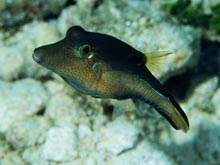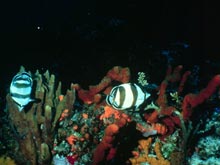The sharpnose puffer fish, Canthigaster rostrata, is our model “lab rat” for predator deterrence assays in the laboratory. Click image for larger view and image credit.
The butterfly fish, Chaetodon striatus, feeding on sponges of a Caribbean reef. Click image for larger view and image credit.
Predator Deterrence
May 26, 2007
Marc Slattery
University of Mississippi
Deb Gochfeld
University of Mississippi
![]() Scientists explain predator deterrence through bioassays of the sharpnose puffer fish.
(Quicktime, 4.3 Mb.)
Scientists explain predator deterrence through bioassays of the sharpnose puffer fish.
(Quicktime, 4.3 Mb.)
Most animals, when chased by a predator, can run away. Not so for many coral reef animals, such as sponges and corals. These animals are more like plants in the sense that they are sessile (attached to the bottom) and can’t move away when a predator tries to take a bite out of them. Instead, sessile animals and plants need to have other types of defenses that protect them from predators. These could include structural defenses, such as hard shells, spines, or prickly spicules. Alternatively, these organisms could produce chemical defenses that make them taste bad.
Corals, for example, have tentacles containing nematocysts (stinging cells) that are used to capture and kill zooplankton prey, and also to sting potential predators. Only a few species of fish, such as the butterfly fishes, are adapted to take advantage of corals as prey. Sponges, on the other hand, are mostly soft-bodied; and because they are often out in the open and brightly colored, they seem like an obvious “dinner” for predatory fishes. Sponges are full of microscopic spicules that may provide some protection from certain types of predators, but more importantly, they produce a plethora of complex chemical compounds (unlike any found in the terrestrial environment), and these provide protection from predators by making the sponges taste bad. We refer to these as "feeding detererent" compounds.
When scientists search for feeding deterrent compounds, we extract all of the chemistry out of the sponge by soaking it in various solvents, and then we test the extract in bioassays to see whether it has any affect against potential predators. Our “lab rat” for these assays is the sharpnose puffer fish, Canthigaster rostrata, which is common throughout the Caribbean. This species is omnivorous, meaning it feeds on algae, sponges, corals, and other organisms on the reef, so it is a good model for testing extracts from these organisms.
The puffer is also a small fish that can be kept in aquaria, where it quickly learns to like the calamari we feed it in our assays. Sponge extracts are placed into a squid paste and allowed to dry into a noodle-like food pellet that is offered to the puffer fish with control pellets (also calamari, but without the extracts). The behavioral response we watch for is regurgitation; when these fish don’t like an extract they spit it out immediately. By chemically fractionating those extracts the puffer fish reject, and testing subsequent fractions, we can ultimately identify specific compounds responsible for this bioactivity. Moreover, we can test these bioactive compounds in a variety of biomedical assays to identify potential biotechnological uses for these natural products.





















